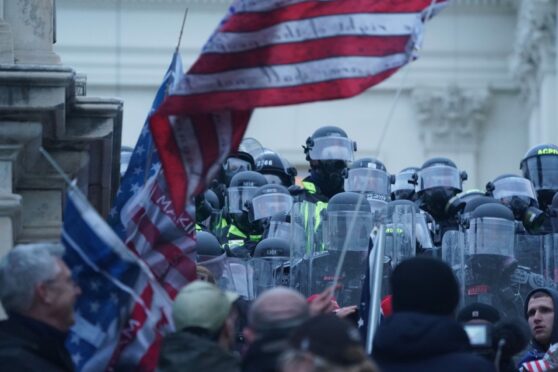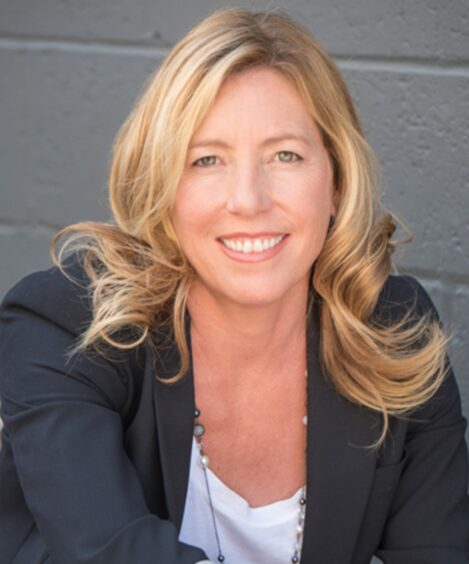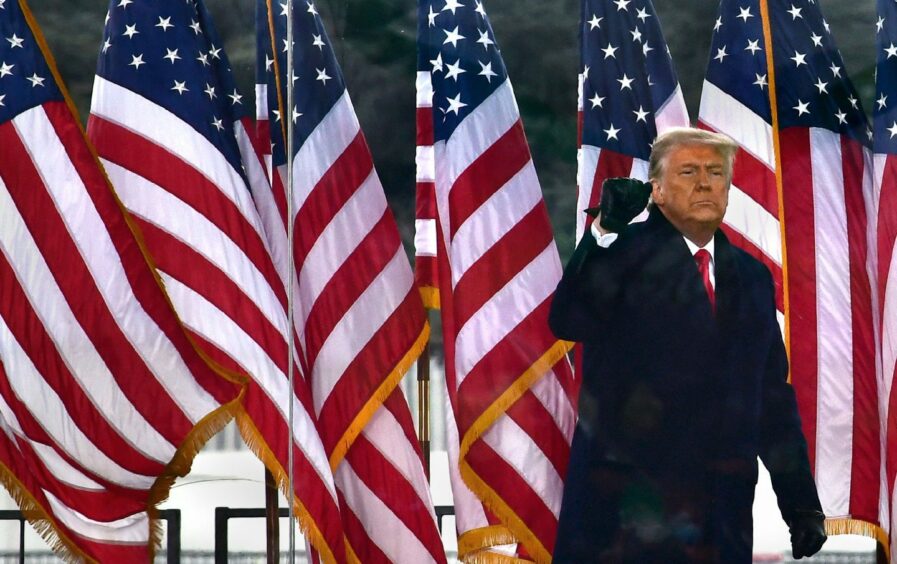
Beneath the high marbled ceilings of the US Capitol, the seat of democracy in the world’s most powerful nation, barked a howling mob.
A year ago, the election of Joe Biden to the office of President prompted violent protesters to storm the meeting place of Congress, the first time the building had been breached in more than 200 years. The ramshackle force, enflamed by the outgoing president’s insistence his rightful victory had been stolen, brandished automatic weapons, Bibles and, crucially, their phones.
As the mostly white, mostly male protesters hurdled barricades, messages from Donald Trump’s nearby speech in Washington were arriving via their social media feeds, along with the hashtag StopTheSteal.
The call to rebellion was dreamed up by Trump and his supporters but it was delivered to them by Silicon Valley. The United States may have stepped back from wider unrest on January 6, 2021 but experts fear the country is in an alarming slide towards not just more violence but civil war.
And the drift towards conflict is, according to one academic who has studied the causes of civil wars around the globe for 30 years, in large part because of the rise of social media. Facebook, Twitter and other platforms have, since becoming popular in the mid-2000s, provided incubation chambers for extreme views; while super-spreading the viral call to violence.
“There were all of these really big, negative societal things happening that coincided with the advent not only of social media but, more importantly, the recommendation engines or the algorithm social media companies designed with the purpose of keeping people on their devices or smartphones as long as possible,” explained Barbara Walter.
“We now know the material that keeps people on their phones for longest is the more incendiary material: anything that taps into the emotions of fear or threat or anger. People tend to not only consume that at a much higher rate but they share it at a much higher rate.”
Walter is a professor of political science and an expert in international and civil wars at University of California, San Diego, and has written How Civil Wars Start, an unflinching look at the rise of political and ethnic violence in the US, drawing comparison with similar situations in Yugoslavia, Iraq and Ukraine. “We know that democracies, especially liberal democracies, began to decline between 2006 and 2010,” she explained. “There was a sudden rise of far-right ethnic nationalist groups across North America, Europe and countries outside those two regions.
“Since around then there’s also been an increase in hate crime while, here in the United States, we know that there’s been a rise in the militia. Is it a coincidence? Social media recommendation engines are feeding more and more extreme material to people who show at least some interest in it. It is helping to radicalise people, it is fomenting hate, it is increasing societal divisions.”
Walter sits on the Political Instability Task Force that models unrest in countries around the world and measures their risk of civil war. It created the Polity Score that measures a nation’s chances of experiencing a civil war. Democratic nations score high on the scale, up to 10. Autocratic nations score lower, down to -10.
Countries high or low on the scale are less likely to experience a civil war; those in the middle, called “anocracies”, a mix of both democratic and autocratic, are in danger of sliding into violence.
The success of the model was around 80%, according to Walter. Worryingly, the United States last year slid to a Polity Score of five because of President Trump weakening the foundations of democracy, although it has since risen back to eight.
However, with individual states in the US dismantling voter protections, as well as continuing political violence, she worries civil war is a possibility. Walter cited the rise of a far-right party propelled by social media in Scandinavia. The Sweden Democrats, she said, was a small group without much influence; newspapers and television would refuse to platform them.
“The postal service refused to deliver their leaflets,” she added. “They couldn’t get their message out. Suddenly, social media appears and they have this tool to reach an enormous audience. Their numbers exploded and today, they’re the third-biggest party in the Swedish parliament.
“We’re seeing it not just in Sweden. We’re seeing it in France, in Germany, and we’ve seen it with the Brexit vote. In the pre-internet, pre-social media age, Brexit wouldn’t have happened.”
Suggesting the US or UK might be about to slide into a domestic conflict might seem preposterous but notions of traditional uniformed troops led by Robert E Lee or Oliver Cromwell across a battlefield are outdated, according to academic analysis.
“It is absolutely crazy for any nascent insurgent group here in the US to think they could take on the modern US military which has over two million soldiers under arms who could be transported anywhere in the country quite rapidly,” said Walter.
“If you’re a small group that’s unhappy with the status quo and you want to change things and you want to challenge the government, you do not want to come head to head with the military.
“You want to operate in the shadows, with a horizontal rather than hierarchical organisation. You want to be very, very decentralised. The far right uses a term here in the US called leaderless resistance, which is where you have multiple militia groups, maybe paramilitary groups, sometimes operating independently, sometimes co-ordinating their activities. They’re using unconventional methods, in particular domestic terror, directed at civilians, or civil servants or opposition politicians.”
There are, according to Walter, two key indicators as to whether a country is at risk of civil war. The first is the Polity Score, and the second is the rise of ethnic factionalism, when political groups emerge around ethnic, religious or racial identities, and where politics devolves into a winner-takes-all fight with other groups.
“When you look at all of these other civil wars and other countries, especially the ethnic civil wars, we know who tends to start them and it’s not the groups most people would think,” she explains. “It’s not the poorest immigrants. It’s not groups that are most oppressed or discriminated against.
“It tends to be the groups that had once been politically dominant but are either losing that dominance or they have already lost it. What seems to be driving their movement to violence is this deep sense of resentment at their loss of status.
“They truly believe the country is theirs. They truly believe they represent what the country ought to be; they truly believe it’s their right to rule. And that’s something the poor segments of society and the immigrants don’t believe.”
Walter identifies “ethnic entrepreneurs” who exploit discontent to gain power: Jair Bolsonaro in Brazil, Narendra Modi in India, Rodrigo Duterte in the Philippines and Viktor Orban in Hungary.
Although our own prime minister has been described as a populist he doesn’t fall into that category, according to Walter. “Boris Johnson hasn’t played on ethnic nationalism, which in some ways makes him unusual because most of the populists who have come to power have been populist but they’ve also been ethnic entrepreneurs: they very much rely on this message the country is theirs and they need to defend it, its identity and culture.
“But, Johnson doesn’t strike me as like that, and he hasn’t played that ethnic card.”
Walter is fearful of the next US presidential election, when an heir to Donald Trump’s strongman persona, perhaps even more determined to cling on to power, could arrive.
“We have found the stronger the democracy, the less likely they are to have a civil war,” she added. “But what are some other things we can do? We have to regulate social media, which would go a long way to soothing these broad divisions in society.
“It would make it much harder for people like Vladimir Putin to have a back door way to sow discontent and to weaken our liberal democracies from afar.
“And citizens themselves have to have to take back their power. There’s a sense of complacency here in the US. Our democracy has been declining and Americans, like Hungarians or Turks, are watching this happen and not really doing anything.
“We require higher voter turnout. Almost 80 million eligible Americans did not vote in the last election, even though turnout in 2020 was extremely high for the US.
“I’m a big advocate of peaceful protests, also. If politicians are only listening here in the United States to a subset of the voters or to special interests then people need to express their dissatisfaction and go out in the street.
“We know from studies that peaceful protests can be very effective.”
How Civil Wars Start: And How To Stop Them, by Barbara F Walter, is published by Penguin
Magazine’s big question provokes huge alarm
The respected New Yorker magazine, renowned for its serious-minded, forensic journalism, raised eyebrows around the world on January 5 after publishing a story under the headline asking “Is a civil war ahead?”
Editor David Remnick, writing before the anniversary of the Capitol riots and citing Professor Barbara Walter’s book and interviewing Steven Levitsky, the co-author of another, How Democracies Die, concluded:
“As the anniversary of the insurrection is observed, the greater drama is not obscure. We are a country capable of electing Barack Obama and, eight years later, Donald Trump. We are capable of January 5, when the state of Georgia elected two senators, an African-American and a Jew, and January 6, when thousands stormed the Capitol in the name of a preposterous conspiracy theory.
“‘There are two very different movements at once in the same country,’ Levitsky said. ‘This country is moving towards multiracial democracy for the first time. In the 21st Century we have a multiracial democratic majority supportive of a diverse society and of having the laws to insure equal rights. That multiracial democratic majority is out there, and it can win popular elections.’ And then there is the Republican minority, which too often looks the other way as dangerous extremists act on its behalf. Let’s hope the warnings about a new kind of civil war come to nothing, and we can look back on books like Walter’s as alarmist. But, as we have learned with the imperilled state of our climate, wishing does not make it so.”
In the magazine’s latest edition, writer Evan Osnos reports on a public event in Idaho in October “when the pro-Trump commentator Charlie Kirk was asked by a fan, ‘When do we get to use the guns?’ The crowd tittered, and the fan continued, ‘I mean, literally, where’s the line? How many elections are they going to steal before we kill these people?’”

Enjoy the convenience of having The Sunday Post delivered as a digital ePaper straight to your smartphone, tablet or computer.
Subscribe for only £5.49 a month and enjoy all the benefits of the printed paper as a digital replica.
Subscribe
